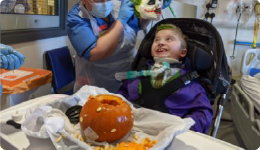Taking Part in Class Work

 Handwriting
Handwriting
Handwriting is part of your daily life – writing a birthday card, filling out a form, making a list. It is an occupation that you do most days. Handwriting is one way for you to express yourself. It can help with the flow of ideas. It shows that you understand what is being taught and in schools handwriting is still the main way you are tested and your progress is reviewed.
Handwriting needs to be taught and develops over time. It is not just being able to hold and control a pencil. It is also:
- having the ideas of what you want to write
- having the words to express what you mean
- making a plan of how to organise your thoughts so that they make sense
- knowing how to make each letter to make up the words
- knowing how to spell words
- knowing how to put the words together to make sentences and paragraphs
- being able to read back what you have written to check it makes sense and is saying what you wanted it to say.
You need to be able to understand language and concentrate on the task. You need memory skills. You need to be able to hold a pencil/pen and control it to make the right movements to make the letters. All of these things have to come together for you to write.
Advice and Strategies
If you find handwriting challenging the first thing you need to do is think about what your goal is. Do you want the examiner to be able to read your exam paper? Do you want to get your point across? This will help you to decide which strategies will help you meet your goal.
- Think about the task
- Make sure you have enough time for the thinking/planning part of writing as well as the doing part of writing. Depending on what you find difficult you might need more time for one part of the task.
- Focus on handwriting for activities that you enjoy, for example writing a shopping list so that you can cook a favourite meal. The same applies in school, maybe you love science so you can write your science work but type or dictate your creative writing in English.
- Try different pencil/pens to find out what works best for you:

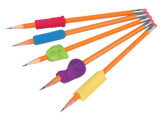 thick, thin, heavy, light, round, triangular pencil/pens
thick, thin, heavy, light, round, triangular pencil/pens- pencils/pens with/without finger rests
- pencils/pens with/without pencil grips
- 2B, HB or 2H pencils
- ball point pen, gel pen, felt tip pen, etc
- Try different types of paper:
- different textures
- different sizes
- different line spacing or try squared/graph paper or dot grid paper
- Think about
- What will help you to feel successful? Are there other ways of showing learning/getting a point across? Do you need extra time? Talk to your family and school staff about how hard you find writing and how much effort it takes to complete written work. Come up with a plan together. Remember you have strengths too. Everyone is good at different things. There is information on other ways to record learning below.
- Trying new strategies. There are lots of different strategies you can try - say it out loud, break the task down, check your work, ask questions.
- Think about the environment
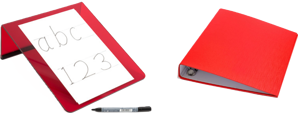 Can you reduce distractions? Put your phone in a drawer, turn off the TV.
Can you reduce distractions? Put your phone in a drawer, turn off the TV.- Think about furniture: Is it easier to write at a standing desk? Are the chair and table at the right height? Would an angled writing surface help?
- Think about space and position in the classroom. Do you need to be close to the teacher? Do you need to be at the end of a table? Would a checklist help with organisation?
Other ways to record learning
Since writing can be tiring and difficult for some young people even with lots of practice and other strategies put in place, using different ways of recording information can be helpful. Sometimes a mix of strategies might work. You could write for some tasks and use other ways of recording for others, this can reduce fatigue and increase confidence with getting thoughts on paper. You could write for maths where there is less to write but use a different way of recording for English or social subjects. All strategies take time to learn and need practice to make them effective.
Other ways of recording learning to try:
 Speaking it out loud (and recording it) and having someone else write it down
Speaking it out loud (and recording it) and having someone else write it down- Using talk-to-text tools
- Having someone (who can read your writing) rewrite what was written to make it easier for others to read
- Draw instead of writing like in comics or graphic novels
- Typing it with or without using computer programmes to help.
It is important to start early to work out what works for you. Whatever strategy works, having extra time is really useful too. This gives your hands and fingers time to rest but also means you have time to get your thoughts and ideas in order and have time to check what you have written too.
CALL Scotland are an organisation who have lots of information about supporting young people to record their work using technology.
Information Technology (IT)
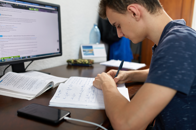 In schools and at home you will use lots of different types of technology as part of your learning and leisure time. You might use a smart phone, tablet, laptop or computer in school. You might play on a games consoles or use a smart phone/tablet to socialise with your friends. Technology can be used to support you in lots of different areas in school.
In schools and at home you will use lots of different types of technology as part of your learning and leisure time. You might use a smart phone, tablet, laptop or computer in school. You might play on a games consoles or use a smart phone/tablet to socialise with your friends. Technology can be used to support you in lots of different areas in school.
CALL Scotland are an organisation who have lots of information about supporting young people to use technology to support learning. They have information about what hardware might be helpful such as different keyboards, mice, screens or switches. They also have information about what software, apps or programmes might be helpful for different reasons and learning needs. They can help with finding different ways to record learning alongside handwriting or instead of writing.
Taking Part in Practical Subjects
Subjects like Physical Education (P.E.), Science, Home Economics and Technical all require different skills. If you are finding the more practical subjects difficult, talk to a trusted adult about this. Tell them:
- What you find difficult?
- What you like about the subject?
- What you find easy?
- What would make the subject more fun for you?
- What interests you about the subject?
- What you think would help?
- What do you want to achieve?
This will help you to work out together what strategies might make things easier. For each subject you find difficult try modifying the task (use different equipment, break it down into steps, focus on your interests) or changing the environment (reduce distractions, think about furniture, think about space and position in the classroom) to make you more successful. Below are some ideas for different subjects.
Physical Education (P.E.)
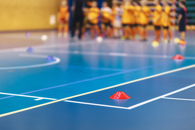 Sport and P.E. are a great way for you to stay active and be healthy. Use P.E. to find a sport or activity that enjoy and might want to continue into your adult life. Sport is not just for players but also fans. Being a sports fan can lead to lifelong friendships.
Sport and P.E. are a great way for you to stay active and be healthy. Use P.E. to find a sport or activity that enjoy and might want to continue into your adult life. Sport is not just for players but also fans. Being a sports fan can lead to lifelong friendships.
Everyone learns in different ways. Ask your P.E. teacher to do what works for you. Sometimes breaking down the activity into steps and taking time to learn each step can help.
Strategies
- If you find team sports difficult, try judo, fencing, golf, running, athletics, gymnastics, dancing or swimming.
- Use a problem solving approach. Break the activity down into steps and work out where things are going wrong. This will help you to work out what you need to change.
- Ask for the P.E. curriculum so you have time to practice ahead of time. You can also learn about the rules and skills required.
- If you need extra time for changing ask school staff for this. Think about the clothes and shoes you are wearing to make it as easy as possible.
Home Economics
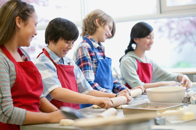 Home economics covers lots of different topics that can help you to make healthy choices, prepare healthy food and be more independent.
Home economics covers lots of different topics that can help you to make healthy choices, prepare healthy food and be more independent.
Everyone learns in different ways. Ask your teacher to do what works for you. Sometimes breaking down the activity into steps and taking time to learn each step can help.
Strategies
- Recipes being in picture form rather than written
- Photo cards of recipe stages, equipment needed, ingredients
- Non slip mats placed under bowls or chopping boards to stop them sliding
- Easy grip utensils such as the “Good Grip” range and ergonomically shaped knifes, where handle and blade are at an angle to each other
- Practice making snacks at home. Try making a sandwich, some toast or a hot drink.
If you are new to using the cooker, microwave, toaster or kettle ask an adult to supervise you to keep you safe.




